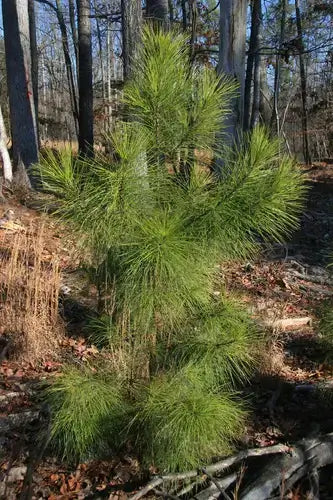Loblolly Pine (Pinus Taeda)
One of the fastest-growing southern pines grows to an excellent 60 to 100 feet tall and 25 to 35 feet wide.
The Loblolly Pine can grow in acidic, drought tolerant, loamy (soil made of silt, sand, and clay), moist, sandy, well-drained, and clay soils at a fast growth rate. It grows best in the hardy growth zones 6-9, and it is found throughout the US from New Jersey to central Florida, making a wide path across the midwest to the West Coast and up to Washington State. The Loblolly, an evergreen, loves full sunlight and can adapt to various sites, including fertile upland fields and moist forests, and grows well mixed with hardwoods.
This fast-growing member of the yellow pine group is an easy seeder. It is planted to help stabilize soil, reduce erosion, and beautiful noise, create a wind barrier, and create a magnificent shade tree.
The leaves are needle-like, 4 to 9 inches long and are in groups of three. The needles are slightly twisted, have a bluish-green tint, are stiff, and stay green all year round. The bark is thick, scaly, grayish-brown, and grows thick with layers.
The flowers of the Loblolly are usually yellowish-orange and give way to cones.
The pinecones are 3 to 5 inches long, dull brown, and prickly.
The Loblolly is also an excellent habitat for many animals, from the enchanting white-tailed deer, wild turkey, and gray squirrels to rabbits, quail, and doves. Many songbirds love to feed on the seeds and help propagate the trees by spreading the seeds to the deer and other rodents. The Red crossbill depends on the Loblolly pine seeds for up to 50% of its diet. Other birds that frequent are the Carolina chickadees, warblers, Bachman’s warblers, northern bobwhites, and brown-headed nuthatches. Bald Eagles and Osprey have also been seen to nest in the tall Loblolly trees. Two endangered species use these pines, the fox squirrels, who eat the cones, and the red-cockaded woodpeckers, who nest in old-growth trees.
The word "loblolly" is a combination of "lob", referring to the thick, heavy bubbling of cooking porridge, and "lolly", an old British dialect word for "broth, soup, or any other food boiled in a pot". In the southern United States, the word is used to mean "a mudhole; a mire," a sense derived from an allusion to the consistency of porridge. Hence, the pine is named as it is generally found in lowlands and swampy areas. Other old names, now rarely used, include “Oldfield pine” due to its status as an early colonizer of abandoned fields; “Bull pine” due to its size (several other yellow pines are also often so named, especially large isolated specimens); “Rosemary pine” due to loblolly's distinctive fragrance compared to the other southern pines; and “North Carolina pine” (source: Wiki).
The Loblolly was once a critical lumber tree due to its abundance and is being studied as a possible alternative energy source today.
Black Pine Tree (Pinus Nigra)
The iconic Black Pine Tree can grow to about 80 feet tall at maturity under the appropriate conditions. Expanding to a width of up to 40 feet sideways, its trunk takes on a silvery black color, and the foliage is a deep green color-forming needle that makes it look dense and bushy. Young trees have a unique density and foliage, and cones appear early in the spring.
Like most pines, the Black pine tree withstands different extreme temperatures but its ideal conditions are in hardiness zones 7-8. This pine tree has a high tolerance to heat during hot summers and to cold winters and high winds, which makes it one of the most desirable varieties of pine trees worldwide.
The Black pine tree grows solid and lush with a good amount of sunshine and in well-drained soil. It has quickly become a popular addition to private gardens and yards as well. It is essential to plant this tree in a spacious and sunny place to give it the freedom to show off its fantastic shape and size.
When you plant a young pine tree, be sure to cut a hole in the ground large enough to double its existing roots. It is critical to ensure its early growth and that the roots get enough water during the first weeks of planting. That will help the tree to develop a strong root system. Young trees grow fast during the summer and release seeds during the wintertime.
Although the Black pine tree thrives in almost any terrain, it prefers a little more acidic and sandy soil. This pine tree does not require a lot of maintenance after planting. Pruning and fertilizing happen naturally, but with some pruning while growing you will get a perfect shape when the tree reaches maturity.
The Black Pine Tree's adaptability to pruning and shaping allows garden enthusiasts to be creative with it, cultivating dwarf versions. This showcases its beauty in a miniature form, similar to bonsai trees.
Shop Our Pine Trees
Visit our online shop for a wide selection of plants and trees, or come say hi at our store location in Tennessee!
We offer fast shipping nationwide so you can start transforming your garden today!
If you have any questions about pine trees or if you have any other plant needs, don’t hesitate to contact us at customerservice@tennesseewholesalenursery.com, we’d love to hear from you!
